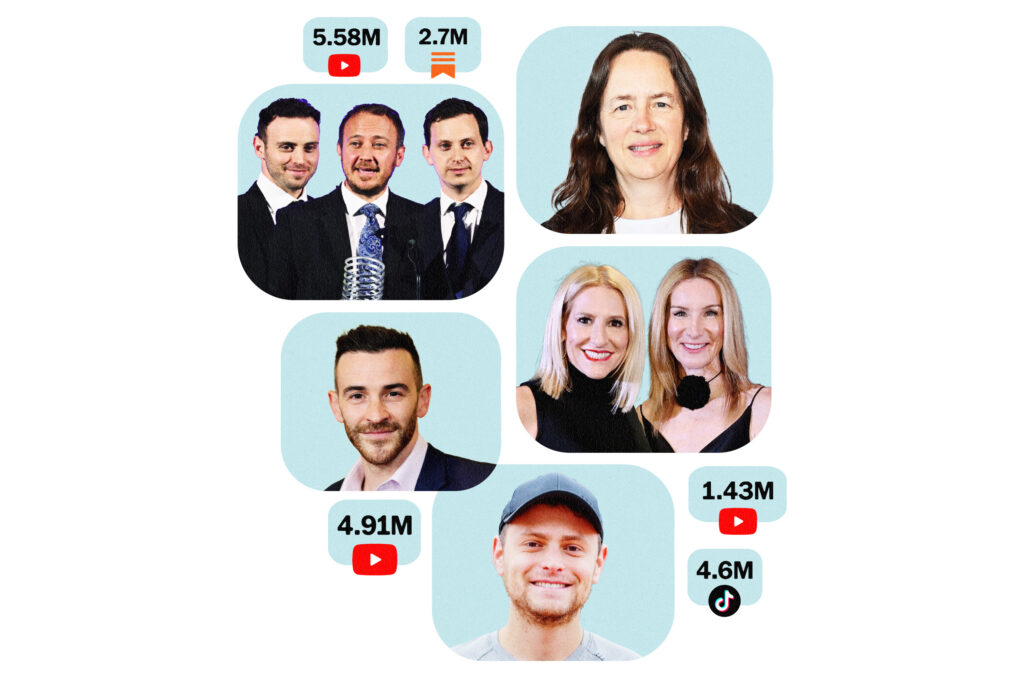AUSTIN — Donald Trump’s victory last November devastated the Democratic Party. But it may have also invigorated its new media strategy.
As Trump and his allies prepared to retake the White House and supercharge its briefing room into an influence operation, Democrats realized they needed to throw out their old media playbook and get serious about finding their own personalities to help them reach a broader swath of voters.
Candidates got the message.
In the months since, it has become nearly impossible to attend a Democratic political event without encountering a “creator hour,” an influencer briefing or a lineup of one-on-one interviews with Substackers and independent podcasters.
State Rep. James Talarico, the most talked-about Democratic U.S. Senate candidate in Texas, dedicated the majority of his campaign launch day here to new-media figures. California Gov. Gavin Newsom, widely seen as a top 2028 presidential contender, spent 45 minutes fielding questions from influencers amid his final push for a major ballot initiative. When Zohran Mamdani won the New York mayor’s race this month, he briefed creators before delivering his victory speech.
The effort has swept across every corner of the party. Former North Carolina governor Roy Cooper, a 68-year-old pillar of the establishment, sat down with liberal influencer Brian Tyler Cohen to kick off his Senate campaign. Sen. Mark Kelly of Arizona, 61, appeared on Substack Live to discuss gun violence after right-wing influencer Charlie Kirk was fatally shot.
“There’s definitely been a shift,” with Democrats willingness to engage, said Jennifer Welch of the “I’ve Had It” podcast.
The show has amassed 1.4 million YouTube followers. Welch and Angie “Pumps” Sullivan, a pair of Oklahomans, boost liberals while irreverently skewering fellow Democrats for being too rehearsed and cautious.
Are Democrats on par with Republicans in the digital media space? Not yet. The gap remains wide, according to audience numbers and interviews with creators and strategists.
Republicans dismiss their efforts as phony.
“What they need to stop doing is trying to copy our homework and go invent something of their own,” said CJ Pearson, a conservative influencer and podcast host. “If they do that, it’ll be a lot more authentic than whatever they’re doing right now.”
Conservatives have a decade-long head start. They spent that time cultivating influential podcasters, social media personalities and digital outlets. Many prominent conservative media outlets emerged in opposition to the Obama presidency — PragerU in 2009, the Daily Caller in 2010, the Washington Free Beacon and Kirk’s Turning Point USA in 2012, the Federalist in 2013, the Daily Wire in 2015. The infrastructure gap shows in the numbers: about 27 percent of news influencers identify as Republican, conservative or pro-Trump, compared with roughly 20 percent who identify as liberal, according to a 2024 Pew study.
But Democrats are making headway, spawning a new class of gatekeepers who are more fractured than cable news hosts or editorial boards that used to serve that function. They’ve become pundits in their own right, acting as representatives of their party in the traditional media, while their own platforms have become the must-hit media circuit for candidates and elected officials eager to reach new audiences.
Candidates and aides have found that these creators often provide friendlier interviews, more passionate audiences and direct pipelines to fundraising and volunteers. Meanwhile, the emerging class of liberal content creators is gaining unprecedented access to politicians, building audiences and competing for influence. The opportunity has proved so lucrative, and the mainstream media environment so weakened, that established figures such as Chuck Todd, Katie Couric and former MSNBC hosts have reimagined themselves as independent media personalities. The result is that Democrats are shifting away from dispassionate news outlets with politically diverse audiences to more siloed political venues. After years of decrying the dangers of information bubbles, Democrats are embracing them.
They are further behind Republicans when it comes to appearing on less overtly political podcasts, such as Joe Rogan’s and Theo Von’s, where Trump and others have reached people who are not interested in politics.
Tara McGowan, founder of Courier Newsroom, a conglomerate of liberal local news sites, said her company has seen its social media following double from 4 million to 8.5 million since Trump was reelected. The growth on the platform and others would have happened faster if the Democratic Party had been more aggressive in its engagement and investment, she said. “All the media energy and investment and innovation that happened to get Trump out of office really dissipated during the Biden administration,” she added, because many Democratic operatives were just exhausted and relieved that Biden won.
Talarico’s path to political relevance runs through Rogan’s studio, which thrust the state lawmaker into an unusually bright spotlight. The openly devout Christian upended assumptions about how Democrats relate their faith to their policy beliefs. When he sat across from Rogan, whose dalliances with conspiracy theories have turned off many Democrats, Talarico cited the Book of Luke as evidence that the Bible allows abortion. He offered Mary’s pregnancy as an example of creation requiring consent.
When Talarico launched his Senate bid in September, he granted access to mainstream outlets. But he devoted even more time to Democratic operatives who now double as content creators, new-media outlets and former network anchors turned independent broadcasters.
As Talarico sat in front of a small plastic tripod holding his phone, his communications adviser Andrew Mamo prepped him for the cast of Substackers and YouTubers who would help him reach a national audience of donors and activists. First up was Mike Nellis, a Democratic operative with 1.3 million subscribers on Substack.
The task would be simple: Rally the digital base to drive up donations.
Before sitting with Chris Matthews, an MSNBC anchor turned Substacker (14,000 subscribers) and Katie Phang, a former host now on YouTube (436,000 subscribers), sponsored by the Democratic MeidasTouch Network (5.6 million YouTube subscribers), Mamo joked about the “funny back-to-back” lineup of MSNBC refugees trying to build audiences on Substack. Before another interview, with Democratic operative Scott Dworkin (236,000 Substack subscribers), he let Talarico know the conversation would be “easy peasy,” with the simple goal to “rally the troops with the base.”
The interviews were largely friendly. Nellis plugged Talarico’s website; Phang called him a friend, told him his launch video reminded her of Abraham Lincoln and cued him up for a fundraising pitch; Matthews described himself as a fan.
The newer class of questioners isn’t that different from the traditional media, Talarico argued in an interview with The Washington Post. Everyone has biases, “even if you pretend to be an objective reporter,” he said, a critique that sounded similar to that of many Republican elected officials.
Many of the independent creators courting Democratic politicians make no such pretense. They are openly liberal, often enthusiastically so, and they usually offer candidates something traditional journalists typically do not: softball questions and fundraising support.
Substack’s audience comprises highly engaged supporters who are likely to volunteer, donate and show up at rallies — exactly the people campaigns want to reach, said Catherine Valentine, who oversees news and politics at the company.
Several Substackers who interviewed Talarico either set him up for fundraising pitches or directly promoted his donation page.
Other Democrats seeking similar audiences, some of whom are eyeing presidential runs, have launched their own Substacks to communicate directly with engaged supporters. They include Newsom, former vice president Kamala Harris, former transportation secretary Pete Buttigieg, Sen. Ruben Gallego of Arizona and former Chicago mayor Rahm Emanuel.
The safe-space expectation has emboldened some politicians to discuss potentially damaging information with partisan outlets. Graham Platner, a Democratic Senate candidate in Maine, appeared on “Pod Save America,” founded by former Obama speechwriters, to get ahead of speculation about his tattoo resembling the Nazi SS Totenkopf. He showed video of his bare chest and said he got the tattoo unknowingly during a drunken night as a Marine. His interviewer accepted the explanation without skepticism.
Todd, the former host of NBC’s “Meet the Press” who now runs an independent podcast, said candidates seek him out rather than the other way around. He suspects his established media credibility offers validation in donor circles, even as he insists his YouTube audience makes him just as mainstream as any cable network.
For ambitious Democrats, appearing on independent media — especially potentially hostile shows — has also become a way to demonstrate versatility and political savvy. The appearances serve as proof of concept to donors and party leaders: I can handle tough rooms and understand how media works in 2025.
Buttigieg appeared on Flagrant, a podcast that hosted Trump during the campaign, then wrote a Substack post dissecting the experience. Rep. Ro Khanna of California has probably done more podcast interviews this year than any other Democrat, including appearances with right-wing hosts like Benny Johnson. These performances are intended to signal competence to party insiders and, importantly, the ability to attract and engage with more hostile audiences.
But even the friendly confines of liberal media can turn hostile. Creators who bring strong political opinions to interviews sometimes push Democrats harder than expected, said Kyle Tharp, author of a newsletter about politics and online influence.
Adam Friedland grilled Rep. Ritchie Torres in a tense exchange about Gaza and antisemitism on “The Adam Friedland Show.” The hosts of “I’ve Had It” unloaded on Emanuel over transgender rights, then pushed Sen. Cory Booker (New Jersey) in an uncomfortable interview, calling him a disappointing corporate Democrat, questioning his AIPAC donations and dismissing his answers as inadequate. These confrontations reveal the limits of treating independent media as a guaranteed safe space.
Tharp predicted the creator class will wield even more power in the 2028 presidential campaign.
“Some of these campaigns are going to be handing them a bag of cash for an endorsement,” he said. “People are really going to want some of these major Democratic talkers’ endorsements in the next campaign.”
The post How Democrats are building their own digital media army appeared first on Washington Post.




